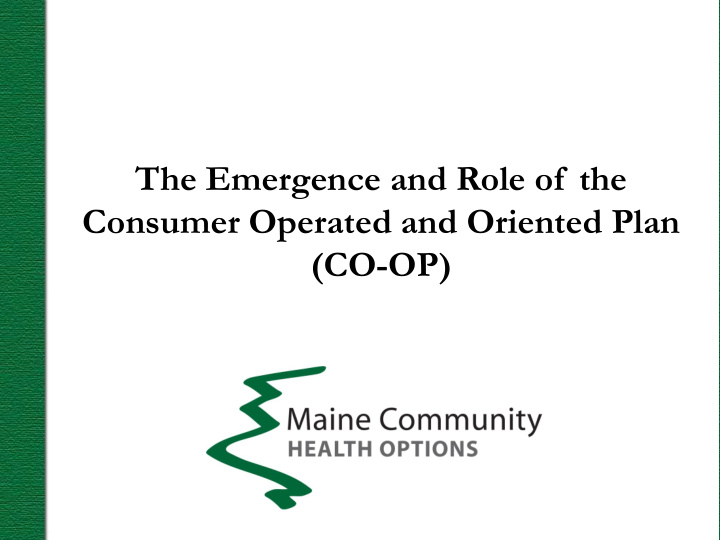



The Emergence and Role of the Consumer Operated and Oriented Plan (CO-OP)
Overview • CO-OPs in Brief • Maine Community Health Options
What is a CO-OP? The ACA (Section 1322) created the Consumer Operated and Oriented Plan (CO-OP) program to foster the creation of new consumer-governed nonprofit health plans.
CO-OP Attributes • Nonprofit: surplus revenues are used to: – Lower premiums; – Improve benefits; – Improve the quality of health care delivered to the people who are members; – Repay loans awarded by the CO-OP program (and any others); and/or – Accumulate reasonable and sufficient reserves to provide for enrollment growth, financial stability and stable coverage for the people who are enrolled • Consumer governed • Greater accountability to the people who are enrolled, providers and payers • Emphasis on high quality, low cost, coordinated and patient-centered care • Afford access to coverage/care • Primarily purchased on the Exchange • Forever non-profit: prohibited from being sold to or converting to a for-profit entity
Maine’s CO -OP: MAINE COMMUNITY HEALTH OPTIONS
Maine’s CO -OP: Maine Community Health Options • The fundamental purpose of MCHO is to create and develop innovative forms of health care delivery and engagement to produce better health care value through improved health outcomes at lower total costs • MCHO’s application was sponsored by Maine’s FQHCs and the Maine Primary Care Association with development support from Maine Health Access Foundation
MCHO Approach Work in partnership with consumers, clinicians, communities and health systems to achieve the “Triple Aim” • Patient-centered approach inclusive of shared decision making • Focus on the prevention and management of disease – Support for local systems that are effective, e.g., care management – Integrate Behavioral Health & Oral Health through benefit design that results in better care processes and outcomes • Promotion of the value of care over the volume of care • Payments and processes that are transparent and easy to understand for the benefit of patients, providers, and payers • Expand insurance coverage and support delivery system transformation
MCHO benefits: Value-Based Insurance Design (VBID) • The MCHO VBID focus is on five “big” chronic conditions, two health behaviors (tobacco use & obesity) and promotion of behavioral health integration and oral health integration • Production of data and quality reporting for clinicians and consumers alike to promote engagement and reinforce VBID • Network design to feature opportunities for shared savings and shared risk
Desired Impacts of MCHO • Right sizing health care: Paying for what matters • Greater investments into primary care & preventive services • Emphasis on consumer engagement • Emphasis on appropriate interventions and getting people to recovery sooner [back to work, back to normal routine, back to family life/support] • Increased patient safety and optimal utilization of pharmacotherapy • Critical importance of behavioral health and oral health integration • Better Coordination, More Time, Lower Costs
Who Do We Expect to Cover?
Exchanges promise competition, choice, clout… • Qualified health plans (QHPs) must meet standards in many areas, including benefit design and consumer protection • Increase competition • Lower costs for people by increasing the size of the risk pool – Congressional Budget Office estimates reduced premiums for the same benefits compared to prior law • Coverage expansion healthier risk pool 7-10% reduction • Economies of scale another 7-10% reduction
Exchange Projections by Origin of Coverage 70000 Forecasted Population in Exchange 60000 10158 50000 7968 40000 24315 30000 Exchange without subsidy 34825 Exchange Subsidy 20000 843 1199 Exchange Employer 23158 10000 17699 13950 8443 2048 1458 0 Current Coverage Status
Changing Marketplace • New individual market dynamic: “Approximately two - thirds of buyers in the market will purchase on state- sponsored exchanges, and the remaining one-third through a variety of other channels.” (Oliver Wyman) • Deloitte projections nationwide: – Uninsured people will decline from 52 million in 2012 to 32 million in 2021 – Health Insurance Exchange will grow to 30 million by 2021 – Exchange volume will grow to account for 83% of the individual market in 2021
A Call For Action We view our establishment of a CO-OP as an opportunity – an opportunity to develop a new model of providing health insurance coverage that entails payment reform, reinvestment into primary care, and lower administrative costs with savings passed directly on to the businesses and people who are the controlling members of our non-profit CO-OP.
For more information: Maine Community Health Options: http://www.maineoptions.org The Center for Consumer Information & Insurance Oversight: http://cciio.cms.gov/programs/ coop/index.html CO-OP Funding Opportunity Announcement (FOA) at: http://www.grants.gov (CFDA # 93.545) CO-OP Final Rule at: http://www.regulations.gov
Thank You Kevin Lewis, CEO Robert Hillman, COO Joyce McPhetres, CHRO Maine Community Health Options 70 Lincoln Street, Suite 1-C Lewiston, ME 04240 207-402-3330 www.maineoptions.org
Recommend
More recommend